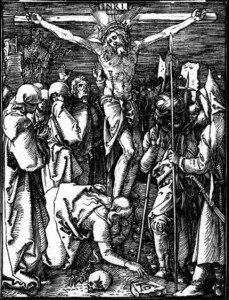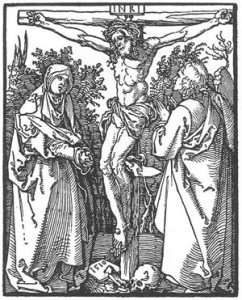 St Mary’s is actually the first church that I’ve worked in which has had the tradition of three hour devotions on Good Friday, so I know well enough that its not the only thing to do on Good Friday. However, its a very particular devotion and one that I’ve grown to love. Indeed, its hard to imagine not keeping it.
St Mary’s is actually the first church that I’ve worked in which has had the tradition of three hour devotions on Good Friday, so I know well enough that its not the only thing to do on Good Friday. However, its a very particular devotion and one that I’ve grown to love. Indeed, its hard to imagine not keeping it.
The idea is that the church marks the time between 12 and 3 pm on Good Friday – the time at which Jesus was on the cross.
Here in Glasgow, the time is usually spent with readings from the Passion, preaching, music for meditation and above all silence. I’m usually amazed at how the time passes and like quite a lot of people, I’m always there for the whole thing. However, some come and go. Its always a hard thing to judge how many people come to church for this part of the triduum because of the coming and going.
The music tends to be solemn and beautiful. I often don’t know until the last minute quite what it will be. The default position is organ music for meditation but usually there are other offerings from Cathedral musicians, some of them stepping forward in Holy Week itself to volunteer something for this service.
The preaching is thoughtful, calm and measured today. Sometimes one person preaches the whole thing and sometimes (like today) its shared. I’ve done the whole thing a couple of times and its a marathon. Those who are more disciplined than I am write an address each week during Lent so that by the time Holy Week comes around all is more or less ready.
The tradition is seven sermons during the three hours. If its one voice, its a real test of a preacher to keep people focused and involved by the end. Sometimes people base it on the seven last words from the cross – the things that Jesus actually said on the cross that are recorded in the gospels. Sometimes its simply preaching on the Passion texts. (That’s what we’re doing today). I’ve known other schemes though too. I’ve heard a whole three hours devoted to the senses – including a wonderful sermon on the smell at the cross. I’ve also heard it done by preaching in the voice of the different participants – Peter, Mary, Pilate, the Centurian and so on.
Sometimes in St Mary’s the Cathedral Choir sing a service at night. If not, like today, when the St Mary’s Chorale is singing in the evening then the choir come for the last hour of the three.
The devotion ends with the singing of the Reproaches – a strange text which captures the bewilderment of the crucified one. “O My people, My people what have I done to you, how have I offended you answer me!” These are not words that Jesus said from the cross at all but an attempt to get inside his experience and to sing something from his perspective on what has happened. They describe the various ways in which God tried to save people in the Old Testament only to be rejected and spurned and see the cross as a continuation of that experience.
Its a long devotion. Its a worthy devotion. Its a holy devotion. And it is worth keeping well.

Recent Comments